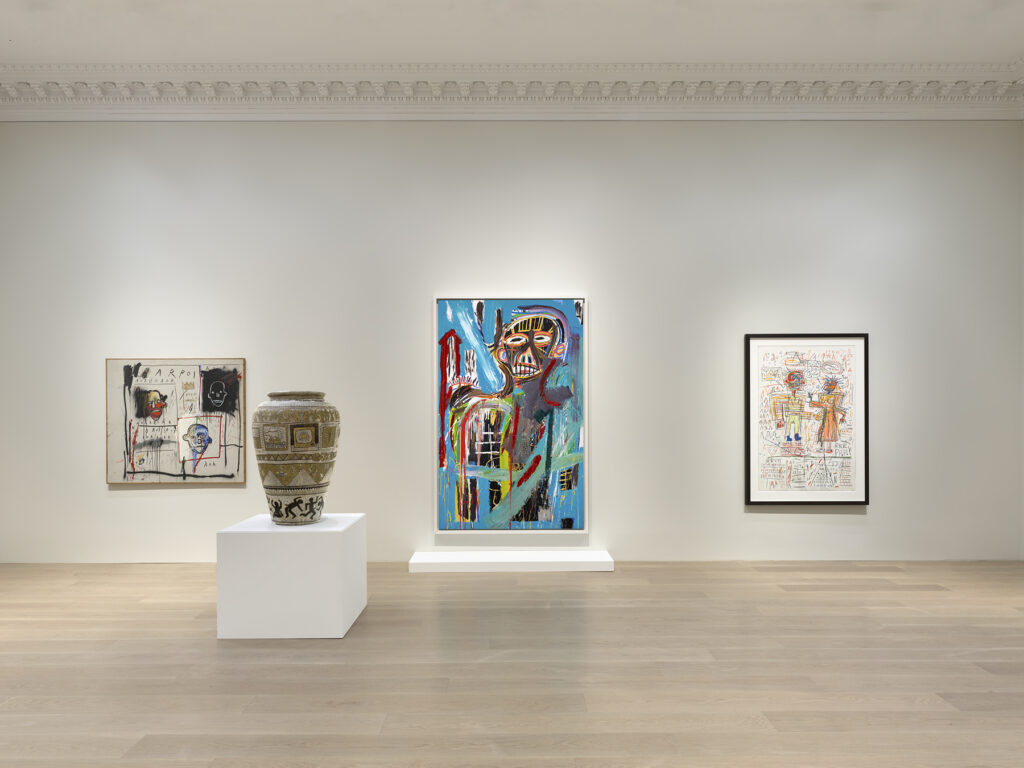Loan Program
Downtown/Uptown: New York in the Eighties
Levy Gorvy Dayan September 23rd, 2025
The Brant Foundation is pleased to loan to the exhibition
Downtown/Uptown: New York in the Eighties
September 18 – December 13, 2025
Lévy Gorvy Dayan 19 East 64th Street, New York New York
PRESS RELEASE: Lévy Gorvy Dayan is delighted to announce the exhibition Downtown/Uptown: New York in the Eighties, organized in collaboration with Mary Boone and opening on September 18, 2025. On view at the gallery’s Beaux-Arts style townhouse at 19 East 64th Street in New York, the presentation will feature important paintings, sculptures, photographs, and works on paper by artists including Jean-Michel Basquiat, Ross Bleckner, Francesco Clemente, Eric Fischl, Guerrilla Girls, Peter Halley, Keith Haring, Jeff Koons, Barbara Kruger, Louise Lawler, Sherrie Levine, Sally Mann, Robert Mapplethorpe, Cady Noland, Ricky Powell, Richard Prince, David Salle, Kenny Scharf, Julian Schnabel, Andres Serrano, Cindy Sherman, Haim Steinbach, Tseng Kwong Chi, Andy Warhol, David Wojnarowicz, and Christopher Wool.
The 1980s New York art scene was a locus of experimentation and creativity. As Boone states, “The ’80s was about discovery and new ideas. There was a feeling of possibility and fluidity, supported by an engaged arts community.” With the city as a catalyst, artists—both emerging and established—probed art history, politics, current events, and visual and consumer culture, and conceived new forms of representation. The crackling artistic atmosphere was inextricable from the tumultuous and transformative backdrop of the decade. Ronald Reagan’s presidency heralded an era of social conformity and conservatism as well as economic swings from recession to prosperity. Cable television appeared at the start of the decade, bringing with it the birth of channels like MTV. Evolving modes of commodification and branding across mass media stoked consumer desire. Amidst the progression of the Cold War and other global conflicts, the HIV/AIDS epidemic was recognized as a social, political, and medical crisis in the United States with New York at the forefront.
The works in Downtown/Uptown: New York in the Eighties represent the diverse and groundbreaking art created during, and in response to, this epochal time—while also highlighting the community shared by the artists on view. Basquiat’s prophet portrait Untitled (1982), Clemente’s self-portrait Name (1983), and Fischl’s The Old Man’s Boat and the Old Man’s Dog (1982), mark a return to figuration, then labeled as Neo-Expressionism, and explore the self, psychology, and narrative. The pervasiveness of graffiti and the melding of high and street art are captured by Basquiat’s text and image Untitled (1981) and Haring’s Untitled (1984). Continuing investigations begun in the late 1970s, Prince’s works probe the nature of appropriation, authorship, and American symbolism in mass visual culture. Questioning identity, Kruger’s Untitled (What me worry?) (1987) harnesses media messaging and modes of reproduction to issue social, political, and feminist critique. The period’s impulse for newness, consumption, and gratification is encapsulated in Koons’s sculpture New Shelton Wet/Drys 10 Gallon, New Shelton Wet/Drys 5 Gallon Doubledecker (1981–86), which further advances the legacy of Pop art.
In response to the proliferation of creativity and public interest in art during the 1980s, alternative venues and galleries sprang up, including artist-run spaces in the East Village as well as pioneering dealers such as Mary Boone in SoHo. Artists gained notable celebrity, resulting in the emergence of the term “art star.” Their predominantly downtown studios became sites of collaboration and documentation—and their appearances at restaurants and nightclubs throughout Manhattan were chronicled by the press. This development was indicative of the integration of art and the mainstream, as Peter Nagy, artist and cofounder of Nature Morte Gallery described in a 1983 interview, “Due to massive hype and exposure, the art world is on the verge of becoming something it’s never been before. More in the vein of popular culture, movies, television, fashion.” He continued, “The whole change in atmosphere can be attributed to Mary Boone-ism and Julian Schnabelism. It’s the mass movement of popular youth culture from music into art.”
Thereby, the 1980s signified a pivotal juncture for contemporary art and society with New York at the intersection. Now, nearly four decades later, Downtown/Uptown encourages viewers to explore the forces of creativity, community, and culture at play and to reconsider and discover anew the art of this singular era. As co-curator Brett Gorvy shares, “This is a period of time where I came into my maturity in the art world. The goal of the exhibition is to provide a new relevancy to the work of 1980s New York for the current and younger generations.”
ABOUT LÉVY GORVY DAYAN Lévy Gorvy Dayan exists to be a trusted and supportive home to artists, estates, and the creative conversation. Helmed by Dominique Lévy, Brett Gorvy, and Amalia Dayan, the gallery aims to use its platform and programming to enhance and extend the reach of artists, and to strengthen their legacies. Lévy Gorvy Dayan strives to use its expertise and influence to make all aspects of art accessible—and to connect artists, museums, institutions, and collectors. Through a tailored approach, the gallery strives to offer outstanding service to our collaborative partners and clients. Founded in art historical study, and informed by the contemporary moment, our exhibitions and publications endeavor to contribute to artists’ practices and connoisseurship. Lévy Gorvy Dayan’s spaces in New York and London serve as destinations for engagement, discovery, and inspiration for artists, the public, and clients—embracing the possibility and power of transformation through art.
